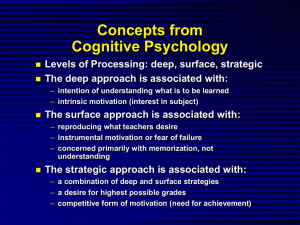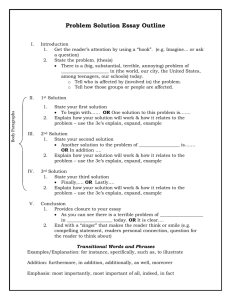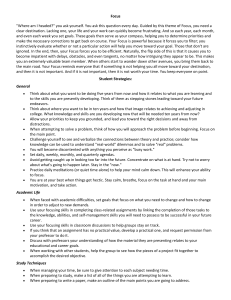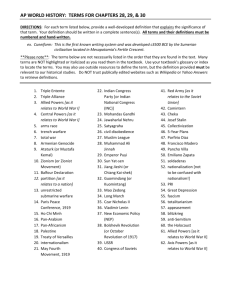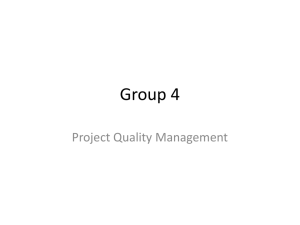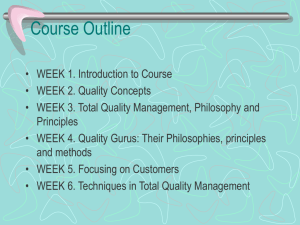Quality of Care
advertisement
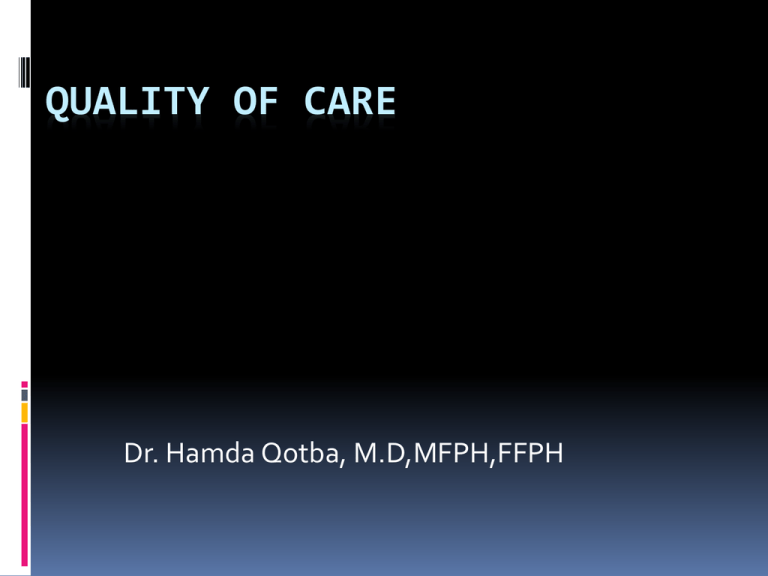
QUALITY OF CARE Dr. Hamda Qotba, M.D,MFPH,FFPH Quality Carrying out interventions correctly according to pre-established standards and procedures, with an aim of satisfying the customers of the health system and maximizing results without generating health risks or unnecessary costs. Conformance to specification Definitions The Oxford English Dictionary (1988) defined quality as “the degree or grade of excellence”. Agency for health care research and quality defind quality as “"the degree to which health care services for individuals and populations increase the likelihood of desired health outcomes and are consistent with current professional knowledge." Definitions National Association of Quality Assurance Professionals described quality as “the level of excellence produced and documented in the process of patient care, based on the best knowledge available and achievable at a particular facility.” the Community Health Accreditation Program defined quality as “the degree to which consumers progress toward a desired outcome” Fitness for use Dimensions of Quality Technical competence Access to service Effectiveness Efficiency Amenities Interpersonal relations Continuity Safety Health care domain Effectiveness • Relates to providing care processes and achieving outcomes as supported by scientific evidence Efficiency • Relates to maximizing the quality of a comparable unit of health care delivered or unit of health benefit achieved for a given unit of health care resources used Equity Patient centered Safety Timeliness • Relates to obtaining needed care while minimizing delays. Health care domain Effectiveness. Relates to providing care processes and achieving outcomes as supported by scientific evidence. Efficiency. Relates to maximizing the quality of a comparable unit of health care delivered or unit of health benefit achieved for a given unit of health care resources used. Equity. Relates to providing health care of equal quality to those who may differ in personal characteristics other than their clinical condition or preferences for care. Patient centeredness. Relates to meeting patients' needs and preferences and providing education and support. Safety. Relates to actual or potential bodily harm. Timeliness. Relates to obtaining needed care while minimizing delays. APPROACHES OF QUALITY Quality Control (QC) Total Quality Management (TQM) Quality Assurance (QA) Continuous Quality Improvement (CQI) Quality Control Quality control in health care organization refers to activities that evaluate, monitor or regulate services rendered to consumers. Observe Identify Track • The process • Variable characteristics • Variables through statistical methods Quality Control Process It is an eight-step process for monitoring and evaluating performance. It must include the following steps: Establish control criteria. Identify the information relevant to the criteria. Determine ways to collect the information. Collect and analyze the information. Compare collected information with the established criteria. Make a judgment about quality. Provide information and if necessary, take corrective action regarding finding to appropriate source. Determine when there is a need for re-evaluation. Total Quality Management (TQM) A way to continuously improve performance at every level of operation in every functional area of on organization using all available human and capital resources. Aim to reduce the waste and cost of poor quality. The main elements of TQM are three: - the customer, whose needs are paramount to the determination of quality, - the teamwork as a mean of achieving quality, - the scientific approach to decision-making based on data collection and analysis. Quality Assurance All of the activities that make it possible to define standards, to measure and improve the performance of services and health providers so that care is as effective as possible Quality Assurance defined as “the process for objectively and systematically monitoring and evaluating the quality and appropriateness of patient care, for pursuing opportunities to improve patient care for resolving identified problem”. The focus of quality assurance is the discovery and correction of errors. These activities are carried out by, quality assurance personnel or department personnel. Quality Assurance Define Quality Measure Quality Improve Quality Standards, norms, guidelines) One cannot measure that which one has not defined • The variation in standards One cannot improve that which one has not measured • Comply with norms Continuous Quality Improvement (CQI) CQI is a cyclical process. It involves identifying an area where there is an opportunity for improvement then outline the sequence of activities that should occur in order to solve that problem, and implementing them. Once the cycle is completed it has to be determined whether the problem has been solved. If the problem continues, the cycle should be repeated. Continuous Quality Improvement Cycle (CQIC) There are seven steps involved in implementing CQI cycle: Step 1 identify an area where opportunities for improvement exists. Step 2 define a problem within that area, and outline the sequence of activities (the process) that should occur in that problem area. Step 3 establish the desired outcomes of the process and the requirements needed to achieve them. Continuous Quality Improvement Cycle (CQIC) cont. Step 4 select specific steps in the process, and for each step list the factors that prevent the achievement of desired outcome. Step 5 collect and analyze data about the factors that are preventing the achievement of the desired outcomes of the desired steps. Step 6 take corrective action to improve the process. Step 7 monitor the results of the action taken
